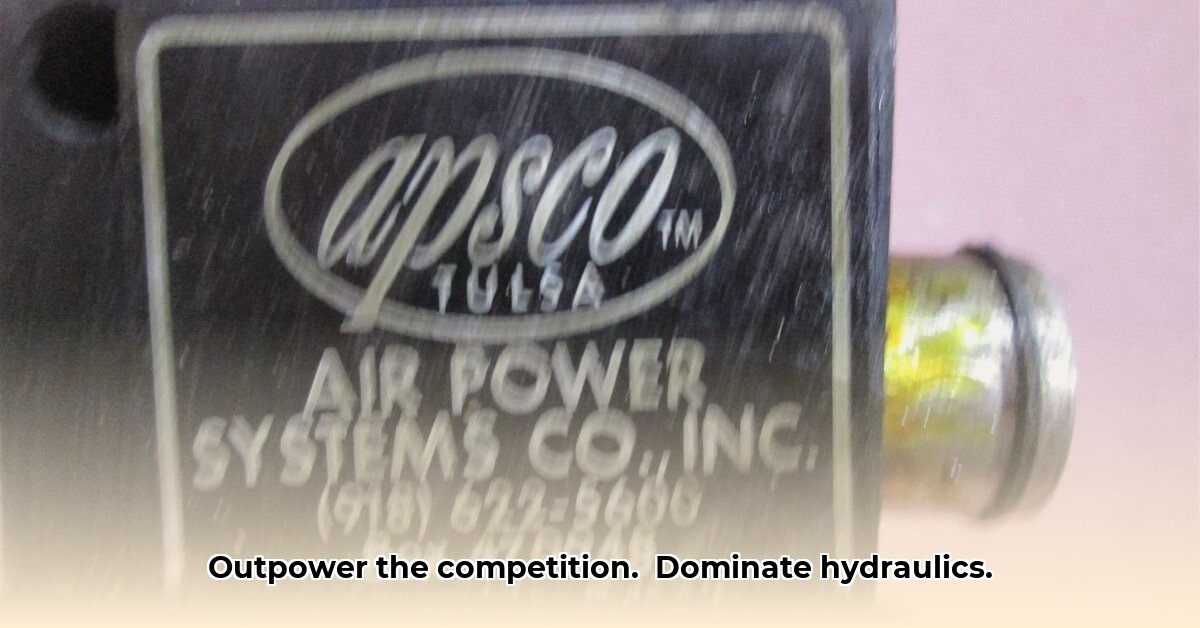
Leading the Charge in Mobile Equipment Hydraulics
APSCO Air Power Systems, established in 1964, is a significant player in the mobile equipment and transportation industries. Their acquisition of STAC Inc. expanded their product line to include a comprehensive range of hydraulic components, such as reservoirs, filters, and the innovative THERMAFLOW® cooling systems, complementing their existing pneumatic cylinder systems. This strategic move solidified their position as a premier supplier of both pneumatic and hydraulic solutions. How has this impacted their market share? Further data on market penetration would strengthen this assertion.
A Focused Approach: Mastering the Class 3-8 Vehicle Market
APSCO's focus on the Class 3-8 vehicle market (medium-duty trucks and similar equipment) allows for specialized solutions tailored to specific customer needs. This targeted approach enables them to cater to both large OEMs and smaller operations, offering customized solutions and flexible production scaling. This contrasts with competitors offering more standardized, "one-size-fits-all" solutions. What percentage of the Class 3-8 market does APSCO currently serve? Data supporting this claim would add significant weight.
Beyond Parts: Building Collaborative Partnerships
APSCO's ISO 9001:2015 certification underscores their commitment to quality. Their success isn't solely attributed to product breadth but also to their collaborative approach and focus on building strong customer partnerships. They actively engage with clients to understand their unique challenges, designing and delivering systems that directly address those needs. This collaborative model fosters long-term relationships, a key differentiator in a competitive market. What is the average customer retention rate for APSCO? This figure would quantify the impact of their collaborative approach.
Filling Data Gaps: Strengthening the Narrative
While anecdotal evidence suggests APSCO’s strong reputation, quantifiable data would further substantiate their market position. Including market share figures, sales growth data, and detailed case studies showcasing return on investment (ROI) would provide more compelling evidence for potential clients, thereby enhancing trust and credibility. What specific ROI data can be provided to showcase the value proposition of APSCO's systems?
Navigating the Evolving Landscape: A Commitment to Innovation
The mobile equipment industry is undergoing a rapid transformation with the rise of electric and autonomous vehicles. APSCO's ability to adapt to these technological shifts will be crucial for sustained growth. Continued investment in research and development (R&D), including exploring new materials and technologies, is essential for maintaining a competitive edge. What specific R&D initiatives is APSCO currently undertaking to address the evolving market landscape?
Understanding the APSCO Ecosystem: A Stakeholder Perspective
The success of APSCO hinges on the success of its partners. Here's how various stakeholders can benefit:
- Original Equipment Manufacturers (OEMs): APSCO offers complete pneumatic and hydraulic systems, allowing for custom design options and potentially leading to strategic alliances for streamlined supply chains and joint product development.
- APSCO Air Power Systems: Market share quantification and competitive analysis, coupled with compelling case studies, are crucial for strengthening their market position. Further diversification of the product line to cater to evolving technologies is necessary for long-term success.
- Industry Analysts & Investors: Independent verification of APSCO’s market position and competitive advantages, along with an analysis of the long-term viability of their strategy, will guide investment decisions.
How to Compare APSCO Hydraulic Systems to Competitors
Ingersoll Rand's acquisition of APSCO highlights the company's strategic importance. However, a thorough comparison with competitors is needed to fully evaluate APSCO's position.
Key Comparison Factors
Effective comparison requires a structured approach focusing on:
Performance Metrics: Analyzing real-world performance data under various operating conditions, including peak loads and efficiency. Independent test results are invaluable.
Durability and Reliability: Examining mean time between failures (MTBF), warranty terms, and service support availability.
Customization and Flexibility: Assessing each manufacturer's capacity to adapt systems to specific needs and handle bespoke modifications.
Cost of Ownership: Calculating total cost, encompassing initial purchase price, maintenance, parts availability, energy consumption, and potential repair costs.
Technical Support and Service: Evaluating the quality and responsiveness of technical support, response times, and expertise of the vendor's support team.
A Structured Comparison Approach
Define Requirements: Clearly specify your needs, including performance parameters, environmental conditions, and budget constraints.
Identify Competitors: Research companies offering comparable hydraulic systems (e.g., Parker Hannifin, Eaton).
Gather Data: Collect specifications, reliability data, service information, and pricing for each vendor.
Analyze Performance: Compare key performance metrics against your specific requirements.
Assess Total Cost: Calculate the total cost of ownership (TCO) for each option.
Evaluate Support: Compare the quality and responsiveness of technical support services.
Make Your Decision: Choose the system that best aligns with your needs and budget.
The Future of APSCO
APSCO Air Power Systems possesses a strong foundation built on quality, customization, and collaborative partnerships. However, continued success hinges upon ongoing innovation and adaptation to the evolving mobile equipment market. By strengthening their data-driven approach and embracing technological advancements, APSCO can solidify its leadership position in mobile hydraulics. The company's future trajectory will be determined by its commitment to continuous improvement and forward-thinking strategies.